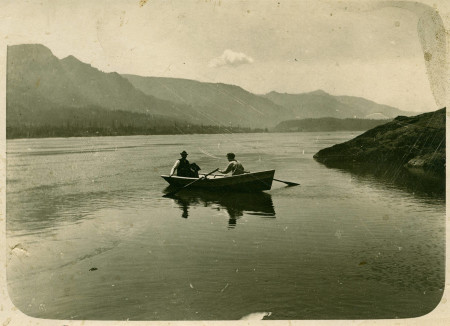Editor of The Pioneer:
(Published in Skamania County Pioneer, January, 1946)
In your editorial “52 Years Old”, which you published on December 21st, last year, you stated among other things that mail came in to Stevenson around 52 years ago via boat from The Dalles or Portland. Permit me, please, to correct that statement. At that time the mail came to Stevenson via rowboat from Cascade Locks. The steamboat, then plying between Upper Cascade Locks and The Dalles, did not carry mail any more after the railroad on the Oregon side of the Columbia River was in operation, which was about in l880.

John Skaar and an unidentified man.
When I came here in 1883 there was no post office on the North side of the Columbia River between Cascade (now North Bonneville) and the White Salmon country. The first post office in that area was established in either 1891 or 1892, near the mouth of Nelson Creek about one mile East of Stevenson and was named “Nelson Creek”. I well remember how happy we settlers were at that time because we could from then on walk (part of the way over a trail) right to the store and post office. No longer was it necessary to make the very inconvenient and often dangerous trip by rowboat to Cascade Locks or to send or receive mail, or to buy groceries. A few years later a post office was established at Stevenson and the post office at Nelson Creek was discontinued. In 1893 the post office “Carson”” was established in Wind River Valley with a twice-a-week mail service and of course we settlers were very much pleased when that event took place.
Carson, as far as the lower valley flat is concerned, had two periods of settlement. Aside from the few very early actual settlers (the Greers, Monaghans, Esterbrooks and St.Martins) the first and temporary settlement took place between 1880 and 1886, at which time a sawmill was in operation where the town of Carson is now. As that sawmill had capacity of sawing 30,000 feet per day, many men were employed at times when the mill ran full time. This sawmill concern took the timber off of more than 1,000 acres and more than half of it they cut unlawfully from government owned land and they got away with it, but once they did not “get by with it” and that incident is worth telling.
It happened in 1886, a short time before they moved the mill to Underwood. There was a stand of timber half a mile west of the mill which they wanted yet. The homesteader who claimed that timber would not, and could not legally, sell the timber, but they were determined to have it and one day they sent in the fallers. The homesteader ordered them off of his land but they threatened to do him bodily harm if he did not leave them alone. The next morning when they came to work they found the road, where it crossed the line, fenced and inside stood the homesteader’s wife with a shotgun threatening to “shoot to kill” anyone who should attempt to cross the line — that helped, they left that timber alone after that. The fact that the shotgun was not loaded they, of course, did not know.
The second and permanent period of settlement started in 1887 when actual settlers took up the logged over land as homesteads.  In September, 1887 when I moved onto my homestead there were, in all, eight families and five bachelors living in Wind River Valley. As
In September, 1887 when I moved onto my homestead there were, in all, eight families and five bachelors living in Wind River Valley. As
we could not make a living on the land at first we had to work out or make cordwood, drive it down Wind River once a year, ship to The Dalles by scow and trade it off for goods mostly, as cash money was very hard to get those days. With the turn of the century came a turn for the better to us settlers.
Pioneering had its charm as well as its hardships. We did not know anything about the modern improvements that the modern people now have and we were happy without them.